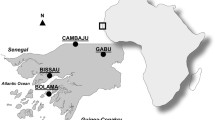Abstract
Methods : A multicentre study to assess iodine deficiency disorders (goitre and deaf-mutism/cretinism) in 1,45, 264 children (6-<12 years old) from 15 districts of ten states was carried out during 1997-2000. Urinary iodine excretion was also determined in 27481 children, while iodine content was estimated in 5881 samples of edible salt. The sampling methodology followed was a “30 cluster survey”.Results : The overall prevalence of goitre was 4.78% (4.66% of grade I and 0.12% of grade II) amongst the children examined. The highest prevalence of 31.02% goitre was observed in Dehradun district, while the lowest prevalence of 0.02% goitre was recorded in Bishnupur and Badaun districts. The overall prevalence of cretinism among children examined from seven districts was 0.072% whereas that of deaf-mutism was 0.27% among children examined from 8 districts. Median urinary iodine values was marginally less than the WHO cut-off values only in children of the 3 out of the 15 districts surveyed. Iodine content was found to be adequate in 55.45% of the salt samples.Conclusion : The results suggested a significant decline in the prevalence of goitre in most parts of the country.
Similar content being viewed by others
References
WHO/UNICEF/ICCIDD. Indicators for assessing iodine deficiency disorders and their control through salt iodization. 1994: WHO/Nut/94.6.
Henry RJ.Clinical Chemistry, Principles and Techniques, 5th edn. Hoeber Medical Division. Harper and Row 1998.
ICMR Task Force Study.Epidemiological Survey of Endemic Goitre and Endemic Cretinism. Indian Council of Medial Research, New Delhi 1989.
Zargar AH, Shaw JA, Masoodi SR, Laway BA, Shaw NA, Mir MM. Prevalence of goitre in school children in Baramulla (Kashmir Valley).Indian J Pediatr 1997; 64: 225–230.
Zargar AH, Shaw JA, Laway BA, Masood SR, Shaw NA, Mir MM. Iodine deficiency and goitre in school children in Srinagar (Kashmir Valley).J Indian Med Assoc 1997; 10(2): 44–50.
Kapil U, Nayar D. Status of salt iodisation and iodine deficiency in selected districts of different states of India.Indian J Public Health 1998; 42: 75–80.
Kapil U. Status of urinary iodine excretion in post iodisatioin phase in selected districts of India.Indian Pediatr 2000; 37: 1282–1284.
National Family Health Survey (NFHS-2) 1998–1999. India. UPS, Mumbai 2000.
Author information
Authors and Affiliations
Consortia
Corresponding author
Rights and permissions
About this article
Cite this article
Toteja, G.S., Singh, P., Dhillon, B.S. et al. Iodine deficiency disorders in 15 districts of India. Indian J Pediatr 71, 25–28 (2004). https://doi.org/10.1007/BF02725651
Issue Date:
DOI: https://doi.org/10.1007/BF02725651




